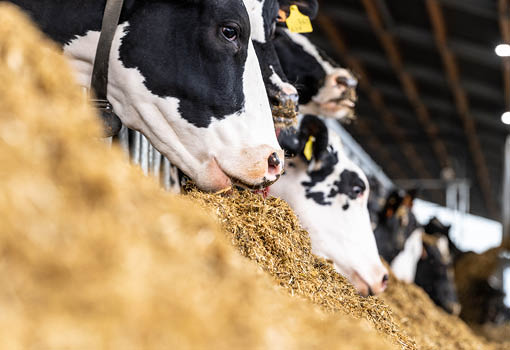Today, there is a huge opportunity for the ruminant industry to produce more efficiently thanks to improved feed. This results in reduced nitrogen (N), Nitrous Oxide (N2O), Phosphorus (P) excretion, and the final total carbon footprint (Carbon dioxide equivalents, CO2-eq). This contributes positively to a more sustainable ruminant production.
Additionally, as the cost of feed can be up to a massive 70% of the total production cost, improving feed has one of the highest impacts on profitability. Therefore, implementing a rumen-protected Methionine and Lysine in the diets of ruminants is an attractive, long-term alternative for our industry in order to reduce the impact of our emissions and to cost-effectively produce more efficiently and with a reduced carbon footprint.

Precision feeding allows nutritionists to be more efficient with the raw materials at hand and to better meet their needs. This is especially so in times where the raw material prices are challenging and where sustainability becomes more and more important to address. As such, we believe that precision feeding needs more attention and is a way to bring about improved practices.
When zooming in on animal nutrition, we often talk about precision feeding as part of a total set of precision farming practices. Precision feeding allows nutritionists to be more efficient with raw materials, better match the needs of the animal’s requirements, reduce feed losses, increase feed efficiency and optimize the output of meat and milk. A change in the protein supply for example can make a huge difference in terms of economics, but also in animal health and welfare.
By being more precise, we can formulate diets that help the sector become more sustainable, resilient, and in line with sustainability requirements and regulations. Precision feeding also means that we look at the animal’s requirements and better adapt the diets to these needs, taking animal species, age group, production status, market needs, and business objectives into consideration.
Less dependence of certain raw materials in our daily formulation to produce milk or meat (for instance Soybean) means better feed cost or less carbon footprint. Better localization of raw materials means less environmental impact and more flexibility in our formulations, improving feed efficiency, and allows the industry to produce GMO-free products to satisfy consumer demands.
We can formulate concentrates and final dairy diets with less carbon footprint (CO2-eq) by balancing for amino acids. Reason is that by implementing Methionine and Lysine we can reduce or remove the use of Soybean meal, or decrease the supply of the high protein or phosphorous ingredients, and this has a positive impact in the CO2-eq excretion.
When you apply the precision feeding concept in your ruminant operations, the amount of total CO2-eq contribution is reduced. This is due to the reduced amount of CO2-eq per kilogram of dry matter supplied to the animal and because a better feed efficiency when it comes to the feed intake of the animal. Instead of slightly overfeeding animals to ensure good growth or production, either in terms of amount or quality of feed, you can focus on providing your livestock with exactly what they need. This reduces the demand for feed and feed waste, which in turn allows those assets to be used to meet other needs, such as biofuel production or human food.
© Kemin Industries, Inc. and its group of companies 2026 all rights reserved. ® ™ Trademarks of Kemin Industries, Inc., USA
Certain statements may not be applicable in all geographical regions. Product labeling and associated claims may differ based upon government requirements.